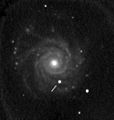astro.wikisort.org - Galaxy
NGC 3938 is an unbarred spiral galaxy in the Ursa Major constellation. It was discovered on 6 February 1788 by William Herschel. It is one of the brightest spiral galaxies in the Ursa Major South galaxy group and is roughly 67,000 light years in diameter.[3] It is approximately 43 million light years away from Earth.[1] NGC 3938 is classified as type Sc under the Hubble sequence, a loosely wound spiral galaxy with a smaller and dimmer bulge.[4] The spiral arms of the galaxy contain many areas of ionized atomic hydrogen gas, more so towards the center.[5]
| NGC 3938 | |
|---|---|
 | |
| Observation data (J2000 epoch) | |
| Constellation | Ursa Major[1] |
| Right ascension | 11h 52m 42.9s[1] |
| Declination | +44° 07′ 17″[1] |
| Distance | 43 Mly |
| Apparent magnitude (V) | 10.9[1] |
| Characteristics | |
| Type | SA(s)c[2] |
| Apparent size (V) | 5′.4 × 4′.9[1] |
| Other designations | |
| UGC 6856, MCG +07-25-001, PGC 37229[2] | |
Three supernovae have been identified within NGC 3938. SN 2005ay is a type II supernova that was discovered on 27 March 2005 and had a magnitude of 15.6.[6] SN 2017ein is a type Ic supernova that was discovered on 25 May 2017 and peaked at magnitude 14.9.[7] Images taken before the explosion point to a progenitor mass between ~47-48M☉, if it was in a single star system, and ~60-80M☉, if it was in a binary star system.[8] SN 2022xlp is a type Ia supernova that was discovered on 13 October 2022 by Koichi Itagaki.
Gallery
- Artist's impression of progenitor star to a type Ic supernova in NGC 3938.[9]
- Spiral galaxy NGC 3938, by HST. Location of SN 2005ay remnant is marked.
- NGC 3938 with supernova SN 2005ay
 The location of SN 2017ein, by HST.
The location of SN 2017ein, by HST.- NGC 3938 by the Sloan Digital Sky Survey
References
- George Normandin (5 May 2005). "Spiral Galaxy NGC 3839". kopernik.org. Retrieved 30 December 2011.
- "Results for object NGC 3938 (NGC 3938)". NASA/IPAC Extragalactic Database. California Institute of Technology. Retrieved 28 February 2021.
- "The Ursa Major Groups". Atlas of the Universe. Retrieved 30 December 2011.
- van der Kruit, P.C.; Shostak, G.S. (1982). "Studies of Nearly Face-on Spiral Galaxies" (PDF). Astronomy and Astrophysics. 105: 351–358. Bibcode:1982A&A...105..351V. Retrieved 25 June 2014.
- Jiménez-Vicente, J.; E. Battaner; M. Rozas; H. Castañeda; et al. (1999). "Fabry-Perot observations of the ionized gas in NGC 3938" (PDF). Astronomy and Astrophysics. 342: 417–425. arXiv:astro-ph/9811391. Bibcode:1999A&A...342..417J.
- "Supernova 2005ay in NGC 3938". Rochester Astronomy. Retrieved 29 January 2013.
- "Supernovae 2017ein in NGC 3938". www.rochesterastronomy.org. Retrieved 29 June 2017.
- Van Dyk, Schuyler; et al. (15 July 2018). "SN 2017ein and the Possible First Identification of a Type Ic Supernova Progenitor". The Astrophysical Journal. 860 (2): 90. arXiv:1803.01050. Bibcode:2018ApJ...860...90V. doi:10.3847/1538-4357/aac32c. hdl:10150/628570. S2CID 56265423.
- "Artist's impression of progenitor star to a type Ic supernova". www.spacetelescope.org. Retrieved 20 November 2018.
External links
 Media related to NGC 3938 at Wikimedia Commons
Media related to NGC 3938 at Wikimedia Commons
На других языках
[de] NGC 3938
NGC 3938 ist eine Spiralgalaxie vom Hubble-Typ Sc im Sternbild Großer Bär am Nordsternhimmel. Sie ist schätzungsweise 38 Millionen Lichtjahre von der Milchstraße entfernt und hat einen Durchmesser von etwa 94.000 Lichtjahren. Sie ist Teil des Ursa-Major-Galaxienhaufens und Mitglied der NGC 4051-Gruppe (LGG 269).- [en] NGC 3938
[ru] NGC 3938
NGC 3938 (другие обозначения — UGC 6856, MCG 7-25-1, ZWG 214.34, ZWG 215.2, IRAS11502+4423, PGC 37229) — спиральная галактика в созвездии Большая Медведица.Другой контент может иметь иную лицензию. Перед использованием материалов сайта WikiSort.org внимательно изучите правила лицензирования конкретных элементов наполнения сайта.
WikiSort.org - проект по пересортировке и дополнению контента Википедии
![Artist's impression of progenitor star to a type Ic supernova in NGC 3938.[9]](http://upload.wikimedia.org/wikipedia/commons/thumb/6/60/Artist%27s_impression_of_progenitor_star_to_a_type_Ic_supernova.jpg/120px-Artist%27s_impression_of_progenitor_star_to_a_type_Ic_supernova.jpg)



